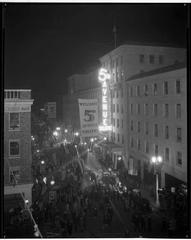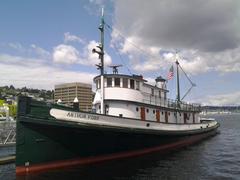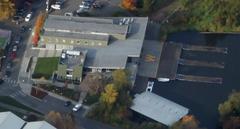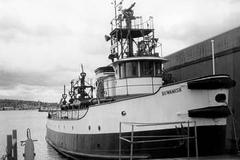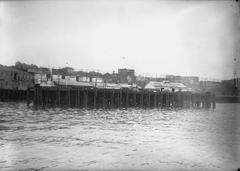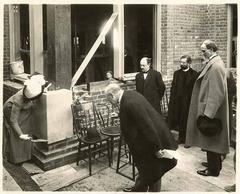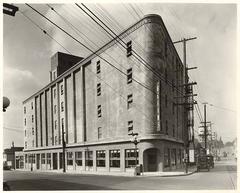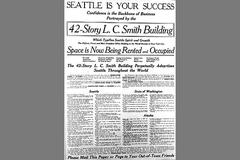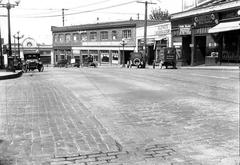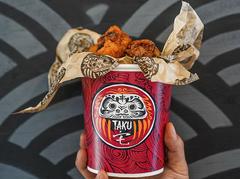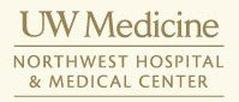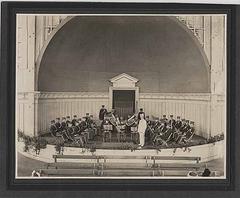
Pacific Science Center Visiting Hours, Tickets, and Seattle Historical Sites Guide
Date: 03/07/2025
Introduction
Nestled within Seattle Center, the Pacific Science Center (PacSci) stands as a renowned institution of scientific discovery, education, and architectural significance. Originally built as the United States Science Pavilion for the 1962 Century 21 Exposition (Seattle World’s Fair), the center quickly transitioned into the nation’s first museum dedicated solely to science and technology, captivating millions of visitors since its inception (Seek Seattle; VacationPass). Designed by Minoru Yamasaki—celebrated for his modernist vision and for designing New York’s World Trade Center—the Science Center is distinguished by its soaring white arches and serene reflecting pools, inspired by Gothic and Japanese aesthetics (SEAtoday; SAH Archipedia).
Designated a Seattle historic landmark in 2012, the Pacific Science Center has steadfastly preserved its architectural heritage while expanding its offerings to include the Butterfly Pavilion, Boeing IMAX Theater, and a robust calendar of educational and community events. Serving nearly a million visitors annually, it remains an essential destination for families, learners, and those seeking Seattle’s vibrant history (Informal Learning Review; Queen Anne News).
This guide provides a comprehensive look at the Pacific Science Center’s visiting hours, ticket options, accessibility, and surrounding attractions, as well as insight into its historical and cultural significance and future developments (GeekWire; Seattle Center News).
Table of Contents
- Historical Background & Architectural Significance
- Planning Your Visit: Hours, Tickets, Accessibility
- Exploring Seattle Center & Nearby Attractions
- Special Events, Tours & Photogenic Spots
- Educational Programs & STEM Engagement
- Visitor Services & Amenities
- Current Challenges & Future Developments
- Frequently Asked Questions (FAQ)
- Plan Your Visit & Stay Connected
- Sources & Further Reading
1. Historical Background & Architectural Significance
1962 Seattle World’s Fair Origins
The Pacific Science Center originated as the United States Science Pavilion for the 1962 Century 21 Exposition, designed to showcase American innovation and optimism. The pavilion’s overwhelming success—attracting nearly 10 million visitors—led to its conversion into a permanent institution, reopening as the Pacific Science Center just one day after the fair’s conclusion (Seek Seattle; VacationPass).
Minoru Yamasaki’s Vision
Minoru Yamasaki’s modernist design features five striking white steel arches, 60 feet tall, that evoke the grandeur of Gothic cathedrals and the tranquility of Japanese gardens. Reflecting pools and fountains further enhance the contemplative atmosphere, inviting guests to experience both scientific discovery and architectural beauty (SEAtoday; SAH Archipedia).
Landmark Status & Preservation
In 2012, Seattle designated the Pacific Science Center as a historic landmark, honoring its enduring architectural and cultural impact. The original structures remain largely intact, even as the center has expanded with new facilities like the Butterfly Pavilion and IMAX Theater (Informal Learning Review).
2. Planning Your Visit: Hours, Tickets, Accessibility
Visiting Hours
- Tuesday–Sunday: 10:00 AM – 5:00 PM
- Closed: Mondays and major holidays
Hours may vary for special events; check the PacSci Events Calendar for up-to-date schedules.
Ticket Options
- Adults: $25–$28 (depending on exhibit access)
- Seniors (65+): $20–$25
- Youth (6–12): $18–$20
- Children under 6: Free
- IMAX and Laser Dome Shows: Additional fee
- Discounts: Available for students, military, and groups
- Memberships: Offer free entry and discounts on special events
Advance online purchase is highly recommended, especially during peak seasons and special exhibitions (VacationPass; Family Vacation Critic).
Accessibility & Amenities
PacSci is committed to inclusivity:
- Wheelchair-accessible entrances, exhibits, and restrooms (Seattle Cultural Accessibility Consortium)
- Sensory-friendly programs and quiet lounges
- Assistive listening devices and ASL interpreters (advance notice recommended)
- Service animal accommodations
- Family restrooms, nursing rooms, stroller rentals
Public transit access is excellent, with the Seattle Center Monorail and multiple bus routes nearby. Parking is available in Seattle Center garages; bike racks are also provided.
3. Exploring Seattle Center & Nearby Attractions
Located within the lively Seattle Center campus, PacSci is steps away from the Space Needle, Museum of Pop Culture (MoPOP), Chihuly Garden and Glass, International Fountain, and the Seattle Center Armory’s food court (ORSeattle; Visit Seattle City). The area frequently hosts festivals, concerts, and family activities.
Additional nearby attractions:
- Seattle Aquarium
- Woodland Park Zoo
- Green Lake Park
4. Special Events, Tours & Photogenic Spots
PacSci offers:
- Guided tours on architecture, science themes, and history
- Special events such as BrainFest, Science After Dark, and traveling exhibitions (Allen Institute; Travel Lemming)
- Signature photo spots: Central courtyard arches, reflecting pools, Butterfly Pavilion
For an up-to-date events calendar, visit PacSci Events.
5. Educational Programs & STEM Engagement
PacSci’s mission is to inspire curiosity and lifelong learning. Programs include:
- School field trips, workshops, and live demonstrations
- Planetarium shows and hands-on labs
- STEAM camps with scholarships for equity (Seattle’s Child; ParentMap)
- Maker & Innovation Lab: A newly developed 14,000-square-foot space with advanced tools for creative STEM learning (Queen Anne News)
- Community outreach via mobile science labs and virtual programs
6. Visitor Services & Amenities
- Dining: No full-service restaurant onsite, but the Armory food court offers diverse options. Outdoor picnic areas are available.
- Gift Shop: Science-themed toys, books, and souvenirs
- Family amenities: Stroller rentals, nursing rooms, baby-changing stations, and rest areas
- Safety: Enhanced cleaning and hand sanitizing stations
7. Current Challenges & Future Developments
Financial & Infrastructure Needs
PacSci faces significant financial and operational challenges, with over $70 million in deferred maintenance and modernization needs (GeekWire). The COVID-19 pandemic affected attendance and revenue, prompting the exploration of new funding streams, including potential real estate sales (GeekWire).
Strategic Partnerships
A new partnership with Seattle Center aims to improve access and integration by removing barriers between PacSci and the broader campus, enhancing visitor flow and collaborative programming, especially as Seattle prepares for the 2026 FIFA World Cup (Seattle Center News).
Maker & Innovation Lab
The flagship Maker & Innovation Lab, with a $20 million budget, will empower hands-on STEM learning for all ages and foster community collaboration (Seattle Center News).
Sustainability & Community Input
Plans to transform reflecting pools into a rain garden and native meadow will support pollinators and urban ecology, reinforcing PacSci’s commitment to sustainability (Cascade PBS). Community input is actively sought to ensure renovations reflect public needs (SEAToday).
Timeline & Outlook
Key upgrades are targeted for completion by the 2026 FIFA World Cup. A long-term strategic plan is in development to guide restoration and growth.
8. Frequently Asked Questions (FAQ)
Q: What are the Pacific Science Center’s visiting hours?
A: Tuesday–Sunday, 10:00 AM–5:00 PM; closed Mondays and major holidays.
Q: How do I purchase tickets?
A: Online or at the North Ticket Booth. Discounts available for seniors, youth, students, and military.
Q: Is the center wheelchair accessible?
A: Yes, with accessible entrances, exhibits, and restrooms.
Q: Are sensory-friendly accommodations provided?
A: Yes, including Exploration for All hours and a Sensory Lounge.
Q: What are the best times to visit?
A: Weekdays and early afternoons are less crowded; check the events calendar for quiet hours.
Q: Is parking available?
A: Parking is available in nearby Seattle Center garages; public transit and bike racks are also convenient options.
Q: Are there guided tours?
A: Yes, for groups and individuals. Check the official calendar for schedules.
9. Plan Your Visit & Stay Connected
Purchase your tickets online, check visiting hours, and review upcoming events before your visit. Download the Audiala app for interactive maps, exhibit guides, and real-time updates. Follow PacSci on social media and explore related articles for more insights on Seattle’s historical sites and family-friendly attractions.
10. Sources & Further Reading
- Pacific Science Center: Seek Seattle
- Partnership Announcement: Queen Anne News
- Visitor Experience: Family Vacation Critic
- Future Developments: GeekWire
- Informal Learning Review: ILR
- Seattle Center News: Seattle Center
- Architectural History: SAH Archipedia
- Courtyard Renovation: Cascade PBS
- Exhibit Highlights: CityPASS
- Tickets & Hours: VacationPass
- Arches History: SEAtoday
- Accessibility: Seattle Cultural Accessibility Consortium
- Camps & Programs: Seattle’s Child
- World’s Fair Legacy: ORSeattle
Experience where curiosity meets discovery at Seattle’s Pacific Science Center—plan your visit today and become part of this landmark’s evolving story.



